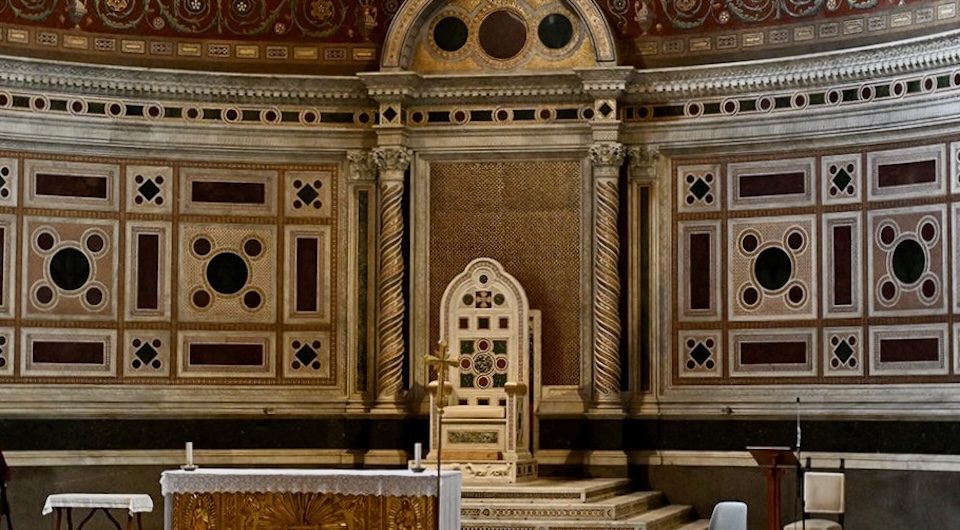

St. John Lateran: The Pope's Cathedral
Matthew Neugebauer
Friday, May 23, 2025

Facade of St. John Lateran Basilica. Photo by Alexander Du. © Salt + Light Media, 2025.
Did you know that the pope has a parish church?
Well, sort of. As bishop of the Diocese of Rome, the pope does indeed have a cathedral church, just like every other diocesan bishop in the world.
That cathedral is the Basilica of St. John Lateran on Rome’s Caelian Hill. Also, just like for every new diocesan bishop throughout the world, Pope Leo XIV will "take possession" of his cathedral in a special Mass this Sunday. He officially became pope and Bishop of Rome the moment he accepted his election, and indeed presided over a public Inauguration Mass celebrating the beginning of his pontificate in St. Peter’s Square this past Sunday (you can read his homily here). However, this coming Sunday he will be solemnly installed as Rome’s diocesan bishop, and sit in the cathedra (the chair, or “see”) of the Successor of St. Peter the Apostle (see image below).
 The official title of the cathedral is “the Major Papal, Patriarchal, and Roman Archbasilica, Metropolitan and Primatial Cathedral of the Most Holy Saviour and Sts. John the Baptist and the Evangelist in Lateran, Mother and Head of All Churches in Rome and in the World.”
That mouthful of a title is long, but that length serves to underline its importance and its longevity: it kept accruing names over the 1700 years of its existence.
The current church building is a 1650 reconstruction by Francesco Borromini, which he built on orders from Pope Innocent X. The original basilica was built in the fourth century, consecrated in 324 (or 318) by Pope Sylvester I and dedicated to the “Christ the Saviour.” As you can see above, it was subsequently also dedicated to both biblical saints named John, first to the Baptist in the 9th century and the Evangelist in the 12th.
The site, originally owned by the Laterani family, has seen the location of Rome’s cathedral since St. Sylvester’s dedication. The pre-existing palace served as the pope's official residence from around the original basilica’s 4th-century construction until the 14th century. That meant that it was also the place where popes and their officials met, worked, and oversaw the Diocese of Rome and the whole Catholic Church.
In the 14th century, that centre of papal power moved to Avignon (an enclave of the papal states) when Pope Clement V took up residence in the French city, while officially continuing to be Rome’s diocesan bishop. When Pope Gregory XI moved back to the Eternal City in 1378, he opted to live and work on the site of Constantine's St. Peter's Basilica in the Vatican, built over the tomb of the first Bishop of Rome. A new Apostolic Palace and a new St. Peter’s Basilica would be built in subsequent centuries.
At this point, the pope's role as chief shepherd of the Church had eclipsed his role as diocesan bishop, which meant that St. Peter's Basilica had eclipsed St. John Lateran's importance. In fact, it was during the Avignon papacy that the day-to-day pastoral responsibilities of the diocese began to be delegated to the Cardinal Vicar of Rome, a bishop who also serves as "Archpriest" or Rector of the Lateran Basilica. The current Cardinal Vicar and Archpriest is Baldassare Reina, who was appointed by Pope Francis last year.
The Lateran Basilica continues to be important as a local point of reference for the papacy. It's a reminder that the papacy isn’t simply an abstract office like the chief executive of a civil institution, but exists because the Holy Spirit sent St. Peter the Apostle and his successors to be pastors of a real group of people in a real place: the Diocese, City, and People of Rome. The pope’s authority derives from Christ’s commission from St. Peter to shepherd the “diocesan community of Rome," whose bishop "presides in Charity over all the Churches” (Pope Francis’ First Urbi et Orbi Greeting, March 13, 2013. See St. Ignatius of Antioch, Letter to the Romans, Prologue).
More interesting facts about St. John Lateran:
The official title of the cathedral is “the Major Papal, Patriarchal, and Roman Archbasilica, Metropolitan and Primatial Cathedral of the Most Holy Saviour and Sts. John the Baptist and the Evangelist in Lateran, Mother and Head of All Churches in Rome and in the World.”
That mouthful of a title is long, but that length serves to underline its importance and its longevity: it kept accruing names over the 1700 years of its existence.
The current church building is a 1650 reconstruction by Francesco Borromini, which he built on orders from Pope Innocent X. The original basilica was built in the fourth century, consecrated in 324 (or 318) by Pope Sylvester I and dedicated to the “Christ the Saviour.” As you can see above, it was subsequently also dedicated to both biblical saints named John, first to the Baptist in the 9th century and the Evangelist in the 12th.
The site, originally owned by the Laterani family, has seen the location of Rome’s cathedral since St. Sylvester’s dedication. The pre-existing palace served as the pope's official residence from around the original basilica’s 4th-century construction until the 14th century. That meant that it was also the place where popes and their officials met, worked, and oversaw the Diocese of Rome and the whole Catholic Church.
In the 14th century, that centre of papal power moved to Avignon (an enclave of the papal states) when Pope Clement V took up residence in the French city, while officially continuing to be Rome’s diocesan bishop. When Pope Gregory XI moved back to the Eternal City in 1378, he opted to live and work on the site of Constantine's St. Peter's Basilica in the Vatican, built over the tomb of the first Bishop of Rome. A new Apostolic Palace and a new St. Peter’s Basilica would be built in subsequent centuries.
At this point, the pope's role as chief shepherd of the Church had eclipsed his role as diocesan bishop, which meant that St. Peter's Basilica had eclipsed St. John Lateran's importance. In fact, it was during the Avignon papacy that the day-to-day pastoral responsibilities of the diocese began to be delegated to the Cardinal Vicar of Rome, a bishop who also serves as "Archpriest" or Rector of the Lateran Basilica. The current Cardinal Vicar and Archpriest is Baldassare Reina, who was appointed by Pope Francis last year.
The Lateran Basilica continues to be important as a local point of reference for the papacy. It's a reminder that the papacy isn’t simply an abstract office like the chief executive of a civil institution, but exists because the Holy Spirit sent St. Peter the Apostle and his successors to be pastors of a real group of people in a real place: the Diocese, City, and People of Rome. The pope’s authority derives from Christ’s commission from St. Peter to shepherd the “diocesan community of Rome," whose bishop "presides in Charity over all the Churches” (Pope Francis’ First Urbi et Orbi Greeting, March 13, 2013. See St. Ignatius of Antioch, Letter to the Romans, Prologue).
More interesting facts about St. John Lateran:

Apse of the St. John Lateran Basilica, with the papal cathedra or "Apostolic See." Photo by Alexander Du. © Salt + Light Media, 2025.
- A number of popes are buried there, most recently Pope Leo XIII.
- The palace hosted four successive Ecumenical Councils from 1123 to 1215, and a fifth from 1512 to 1517. The fourth in 1215 is the most important: among other things, it defined the doctrine of Transubstantiation as the Church's understanding of the Real Presence in the Blessed Sacrament.
- In 1929, the Lateran Treaty between the Italian Government and the Holy See was signed in the palace, hence the name of the treaty. It established the sovereignty of the Vatican City State, ensured the Holy See's overall political independence, and kept the pope's extraterritorial possessions in Italy in Vatican hands. These properties include the Lateran Basilica itself, the other three papal basilicas, and various other Vatican institutions.
- The palace currently houses the offices of the Vicariate of Rome, the Vatican Historical Museum, and the residence of the Cardinal Vicar. It also features the Santa Scala, or “Holy Steps,” believed to be the stairs leading to the praetorium in Jerusalem, which Jesus climbed before his trial by Pontius Pilate. Climbing the steps on one’s knees is a deeply important penitential devotion.
Related Articles:
<<













